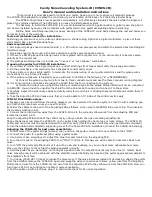
71
,,,,,,,,,,,,,,,,,,
,,,,,,,,,,,,,,,,,,
QQQQQQQQQQQQQQQQQQ
QQQQQQQQQQQQQQQQQQ
¢¢¢¢¢¢¢¢¢¢¢¢¢¢¢¢¢¢
¢¢¢¢¢¢¢¢¢¢¢¢¢¢¢¢¢¢
PARAMETER EDIT
The AUTO ACCOMPANIMENT feature works by automatically re-harmonizing the “source pattern” to match the
specified chords. This is done on the basis of NTR (Note Transposition Rule) and NTT (Note Transposition Table)
settings that, in the PSR-8000, can be individually set for each part and each section.
■
PART/SOURCE ROOT/SOURCE CHORD
.......
These settings determine the original key of the source pattern
(i.e. the key used when recording the pattern). The default, CM7
(the source root is “C” and the source chord type is “M7”), is
automatically selected whenever the preset data is deleted prior
to recording a new style, regardless of the source root and chord
included in the preset data.
Use the
PART
dials to select a part in the currently selected
section, then use the
SOURCE ROOT
and
SOURCE CHORD
dials to specify the desired root and chord (these parameters
may appear as “
PLAY ROOT
” and “
PLAY CHORD
”. See
“NOTE”, below).
■
NTR/NTT
............................................................................................
The
NTR
dials specify the transposition rule to be used by
the transposition table. Two settings are available:
The
NTT
dials specify the note transposition table to be used for
source pattern transposition. 6 table types are available:
The Custom Style Creator
ROOT TRANS.
When transposed the pitch relationship
between notes is maintained. For example,
the notes C3, E3, and G3 in the key of C will
become F3, A3, and C4 when transposed to
F. Use this setting for parts that contain
melodic lines.
ROOT FIXED
The note is kept as close as possible to the
previous note range. For example, the notes
C3, E3, and G3 in the key of C will become
C3, F3, and A3 when transposed to F. Use
this setting for chordal parts.
BYPASS
No transposition.
MELODY
Suitable for melody line transposition. Use for melody parts such as PHRASE 1 and PHRASE 2.
CHORD
Suitable for chord transposition. Use for the CHORD 1 and CHORD 2 parts when they contain piano
or guitar-like chordal parts.
BASS
Suitable for bass line transposition. This table is basically similar to the MELODY table, but recognizes
“on-bass” chords allowed in the FINGERED 2 fingering mode. Use primarily for bass lines.
















































